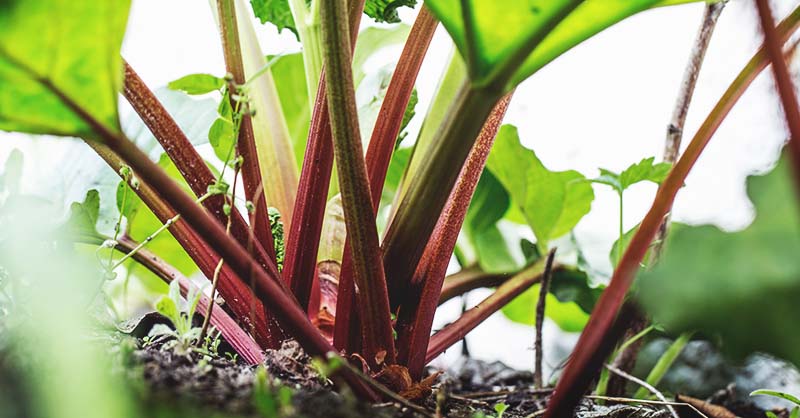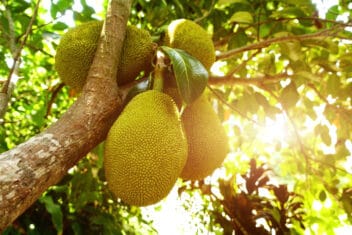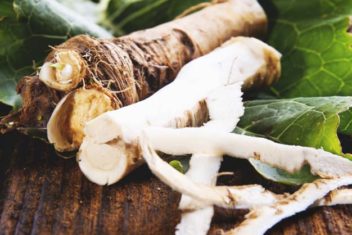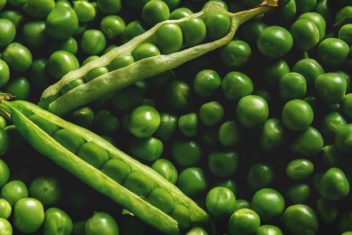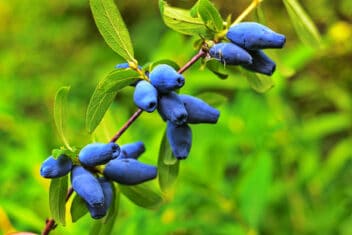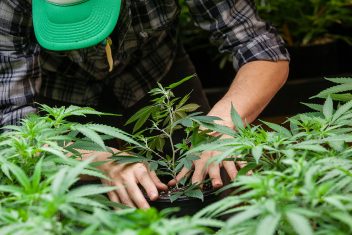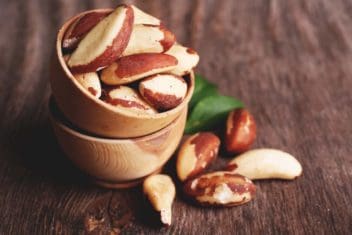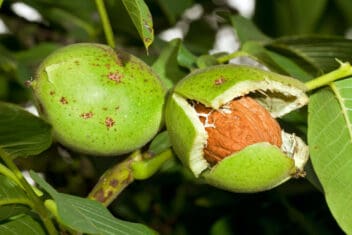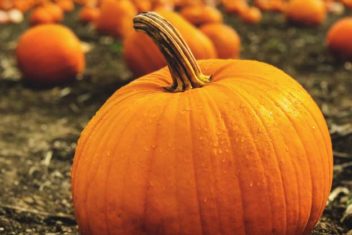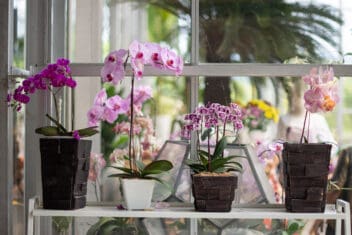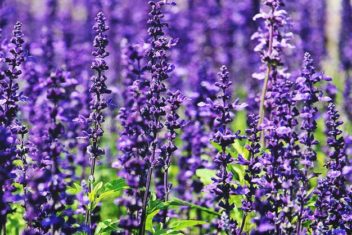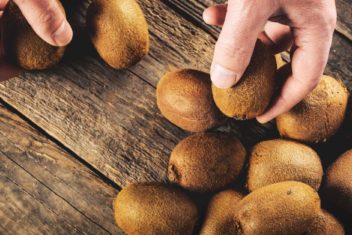Rhubarb. Pronounced roo-barb, is a funny-sounding name for a vegetable isn’t it?
As funny as it may sound, it’s a fun plant to grow. I wanted to begin growing it a few years ago because I heard of rhubarb pie.
Once I knew there was a pie in my future, I got busy planting. Rhubarb is one of the few vegetables that is mostly served sweet.
Unsure if you have what it takes to grow the vegetable that can pass as a sweet treat? Follow along with me as I fill you in on all you need to know about growing rhubarb.
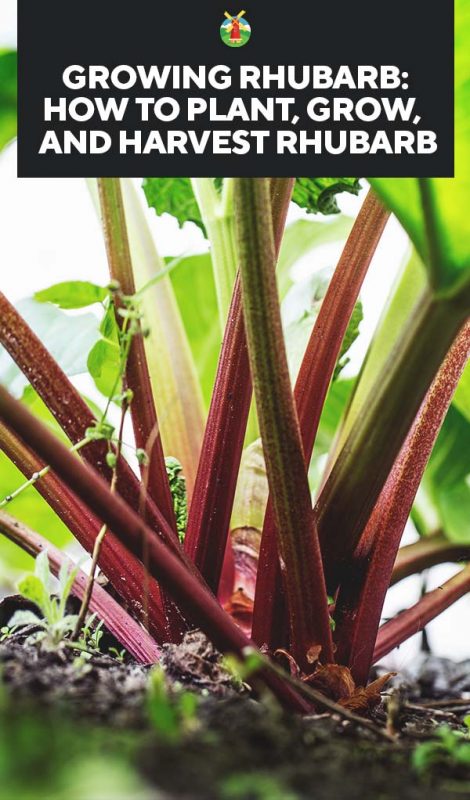
Rhubarb Plant Info
- Hardiness Zones: 3, 4, 5, 6 (perennial), 7, 8, 9, 10 (annual)
- Soil: Clay, loam, sandy, PH between 5.5 to 6.8, well-drained, rich in organic matter
- Sun Exposure: Full sun, 4 to 8 hours of sunlight per day
- Planting: In early spring when soil temperature reaches 40 degrees Fahrenheit
- Spacing: 3 to 4 feet between plants and 5 to 6 feet between rows
- Depth: 1 to 2 inches
- Best Companions: Columbine, garlic, onion, beans, sweet pepper, broccoli, cauliflower, cabbage, kale, asparagus, strawberry, horseradish
- Worst Companions: Turnip, carrot, potato
- Watering: Rhubarb needs constant moisture, but they don’t like to have wet feet
- Fertilizing: Apply high-nitrogen fertilizer after the first spring frost
- Common Problems: Gray mold, crown rot, phytophthora leaf rot, slugs, tarnished plant bug, potato stem borer, rhubarb curculio beetle, anthracnose, botrytis, ascochyta leaf spot, ramularia leaf spot
- Harvest: In the first year of planting, you shouldn’t harvest your rhubarb at all. It is okay to harvest during year two, but do so sparingly. By the time you reach year three, you should have an eight to ten-week period where you can harvest from the plant.
Best Rhubarb Varieties
There are many different varieties of rhubarb to choose from. Here are some of the best options:
Holstein Blood Red
This variety of rhubarb is one of the red options. It contains a lot of juice, which makes it particularly tasty when served with sugar.
If you want red rhubarb to enjoy as a side dish or a dessert, then you might enjoy this classic variety.
McDonald’s Canadian Red
As the name suggests, this is another red variety of rhubarb. It’s particularly good for freezing and baking with.
Canada Red
Canada Red is another red option for rhubarb. It boasts a sweet flavor and packs a lot of juice as well.
Colorado Red
The Colorado Red variety looks like red celery when it grows. That gives you an idea of the size stalks it can produce.
If you’re looking for a pretty red rhubarb variety to use to make scrumptious jams, then this variety is great for that as well.
Victoria
Victoria is one of the oldest varieties of rhubarb. The stalks aren’t small, but they aren’t large either. It is a nice mid-size producer.
But the stalks are more of a deep red versus traditional bright red coloring. The red stands out closer to the base of the plant. When you look towards the leaves, you begin to see the stalk turn green.
Riverside Giant
Not everyone who grows rhubarb wants a red variety. Some people prefer the green variety of rhubarb. If this is you, then you’ll like the riverside giant variety.
Not only are the stalks green, but this variety is also great in cold weather. It’s durable and cold-hardy.
Turkish
Would you like to grow a green variety of rhubarb that doesn’t have a robust flavor to it? If so, then this could be your variety.
This variety’s flavor is tamer than some. It’s recognizable because it produces a solid green stalk, though there is a hint of red at the base of the plant.
German Wine
This variety of rhubarb is fun. It doesn’t just produce a plain colored stalk – the stalks are polka-dotted. It’s also known for being the sweetest variety of rhubarb out there.
The Sutton
This is another fun variety of rhubarb to grow. It doesn’t produce a basic colored stalk, either. Instead, it produces green and red striped stalks.
This variety produces a pleasant scent and is known for being tender. Its flavor isn’t overpowering.
Sunrise
The Sunrise variety of rhubarb is another variety that is outside of the box from what you might think of when you think rhubarb. It produces pink stalks.
However, don’t let the lighter color fool you. It is still a great variety to use for canning, freezing, and making jelly too.
Timperley Early
This variety is one that produces early, as the name suggests. If the weather is cooperative, it can produce in early spring which is months earlier than most other varieties. You can often even get a small harvest from this variety in the first year.
This variety is known for being more disease resistant.
Glaskins Perpetual
Our final variety is the Glaskins perpetual. This is another bright, red variety that produces flavorful stalks. This variety is meant to be harvested late in the season.
Rhubarb has oxalic acid in it. This is what gives raw rhubarb such a bold flavor. In most varieties, the later the season the higher the amount of oxalic acid. In this variety, the oxalic acid is low which makes the rhubarb palatable longer.
Planting Rhubarb
Have you ever heard the saying “There is more than one way to skin a cat?” I’m not sure who came up with such a saying, but it applies to rhubarb.
There are different options for growing it, and it varies greatly depending on what zone you live in. See which option is best suited for your situation.
Planting Zones for Rhubarb
It’s important to know that rhubarb grows differently depending on where you live.
If you live in USDA zones 1-6, rhubarb is a perennial plant. That means it will come back year after year.
Zones 7-8 are a bit trickier because they are on the borderline of too hot. Too much heat can interfere with the production, but rhubarb is considered a perennial in these zones still. The only thing to know is that it might not live as long or produce as much.
In zones 9-10, rhubarb grows as an annual. It won’t come back year after year, but you can plant it and enjoy it each year.
The ideal location is where the soil temperatures drop below 40°F during the winter and have lows around 75°F during the summer.
Sun and Soil Requirements
Rhubarb does tolerate shade, but it will grow best in full sunlight. You need to make sure it’s a location that will have consistent moisture that won’t drain way too fast.
Rhubarb is a heavy feeder, so you need to make sure you have fertile soil that is high in organic matter. Add plenty of compost to your garden beds before planting, along with rotted manure.
You also want to make sure the soil is also well-draining. Compost can increase drainage as well, but you could add peat moss as well.
If you want to make sure that your soil is the right pH, you can test your soil. Rhubarb likes soil that has a pH level of 5.5-6.5.
When to Plant Rhubarb
You can plant rhubarb in the fall or early spring.
If you choose to plant in early spring, be sure to do so as soon as the ground becomes workable, prior to the roots of the rhubarb awakening from dormancy.
If you’re going to plant rhubarb from seed, start the seeds inside 8-10 weeks before the final frost date.
If you choose to plant in the fall, wait until the roots of the rhubarb have fallen dormant, which usually happens in September.
Southern gardeners need to plant their rhubarb in the fall for harvest in later winter or early spring. Start your seeds indoors in mid-to-late August. Southern gardeners should plan to put them in the garden in late September or early October.
Planting Seeds or Crowns
You can plant “crowns” of rhubarb or plant rhubarb from seed.
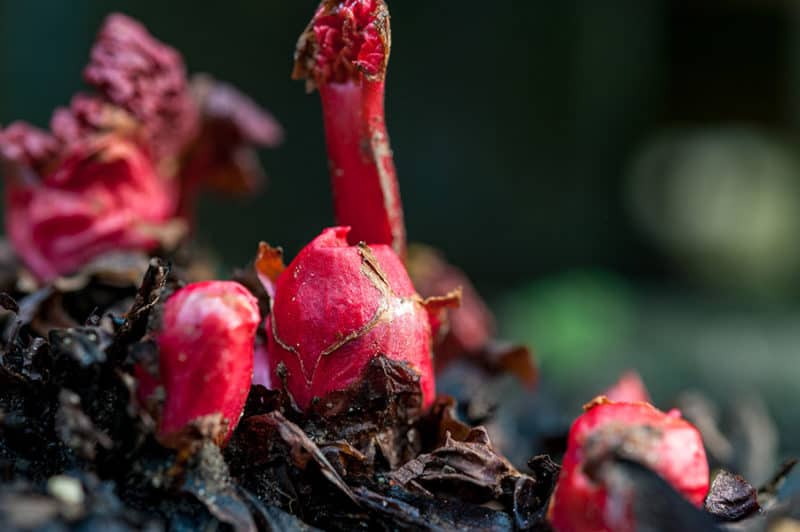
In most cases when you decide to grow rhubarb, you’ll start with a crown, either from a friend who divided their rhubarb or from a set that you purchase at the store.
If you live in a region that is hot and where rhubarb is grown as an annual rather than a perennial, you’ll need to start rhubarb from seed. Starting from seeds doesn’t need to be too complicated.
- Before you start the seeds inside, soak them in water for 10-12 hours. Soaking seeds is a valuable step because it softens the exterior cover and allows the seeds to germinate faster. Don’t skip this tip!
- Fill 4-inch pots with potting soil or seed starting mix.
- Put two seeds in each pot and water well.
- Keep your seeds indoors at room temperature.
- Once sprouted, you can move the seedlings to a bright window to grow.
- Once your seedlings are 2 inches tall, move the seeds to a shady location to harden off, gradually introducing more sun each day. Continue to keep the soil moist but not soggy.
- After several weeks, you can move the seedlings to a brighter location with morning sun.
Transplant
Once your seedlings are ready to go outside, they can be safely transplanted when they are 4 inches tall with 3-5 leaves on each plant.
Transplant your rhubarb seedlings two weeks before the final frost of the season. This allows the roots to get established while it’s still cool.
By the time you transplant, your rhubarb should be four inches tall. You want to be sure to mulch around the seedlings to keep the roots cool and to keep moisture even.
Do not fertilize when planting or for the entire first year. Rhubarb exposed to nitrates early on in life can kill it.
Spacing
When you plant rhubarb, make sure that you dig a large hole for each plant that is around a foot deep. Rhubarb has large root systems making spacing important.
Space each plant around 3-4 feet apart and plant each crown two inches deep in the soil.
Be Patient
Unless you plant a special variety that is known for producing an early harvest, you probably won’t get a harvest from your rhubarb in the first year.
This means that you need to have patience. The following year, you’ll likely have a big, healthy harvest.
Ways of Growing Rhubarb
There are four different ways that you can grow rhubarb. Here are your options:
Grow Rhubarb in a Container
If you live in an apartment or where you only have a small yard, then you might be interested in container gardening.
If so, then you’ll be happy to know that you can grow rhubarb in a container. You’ll just need to make sure that the pot can hold around ten gallons of compost or planting mix because of the large root system of rhubarb.
Plant Rhubarb in Raised Beds
Raised beds are a great option if you don’t have a lot of space or if you want a garden that’s easy to access. Be sure your garden is at least 8-inches deep to accommodate the roots.
Plant Rhubarb in a Traditional Garden Setting
As discussed above, rhubarb does well in a traditional garden bed.
Grow Rhubarb in a Greenhouse
You can also grow rhubarb in a greenhouse setting. You can choose to have raised beds in a greenhouse, or just move your potted plant into the greenhouse when the temperatures begin to change.
Caring for Rhubarb
Rhubarb is a low-maintenance plant, but there are a few things you can do to make it prosper.
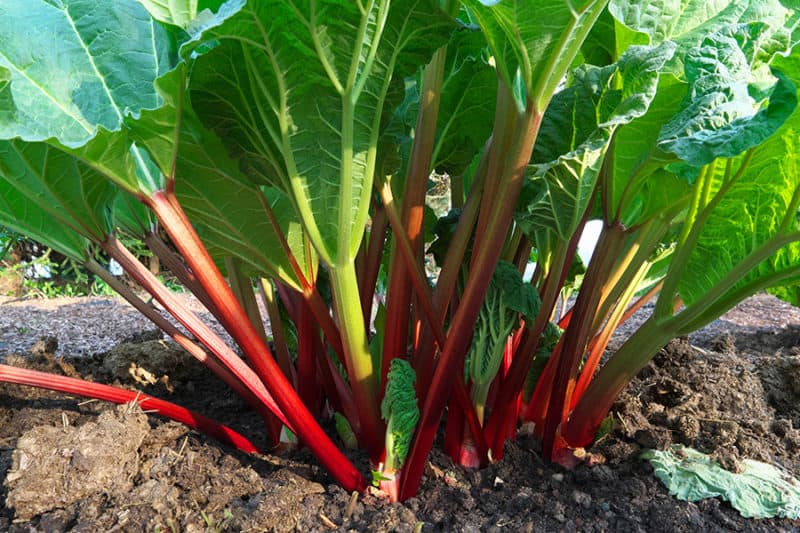
Mulch
Adding a thick layer of mulch in the spring (or fall depending on when you plant) is an essential step. A thick layer of mulch holds in moisture, keeps the roots cool, and reduces the weeds.
Water
Rhubarb needs constant moisture, but they don’t like to have wet feet. They don’t want soggy soil.
If you live in a region that receives a lot of rain, such as the Pacific Northwest, you might not need to provide any extra water. If you live in a dry or hot region, you’ll need an irrigation system to provide consistent moisture.
Don’t Let It Go to Seed
Anytime you see a plant begin to bolt (or go to seed) this means that it’s getting ready to stop producing juicy stalks, and will start to produce seed for the next growing season, instead.
At the first sign of going to seed, cut those stalks off to prolong your harvest
Fertilize…But Only After Year One
It’s a good idea to fertilize your rhubarb plants. You don’t need to apply any fertilizer during the first year but in the second year and all years following, apply 1/2 cup of 10-10-10 fertilizer in the spring and fall.
Make a circle around the base of your plant and put the fertilizer in the circle. Avoid applying fertilizer to the crown.
Remember not to fertilize your plants when planting. The compost that you added to the soil is enough to feed your plants for the first year. Adding fertilizer in the first year will expose your rhubarb to too many nitrates. That could kill your plants.
Control the Weeds
Keep the weeds out of your rhubarb patch. Rhubarb is pretty good about being left alone by both bugs and disease. However, weeds attract them and put your plant at risk.
Divide Your Rhubarb
Rhubarb continues to grow and spread each year, so it’s important to dig and split your rhubarb roots. This will need to be done every 3-4 years.
Dividing your plants should be done when your plant is dormant, typically in the early spring or the fall.
Dig up the entire plant, including the roots. Dig down about 6 inches deep, getting under the root system and pulling the plant out.
Then, divide out the root ball, which is made of the root of the plant and the buds. You need the buds to form new plants. When you divide it, cut down the crown, between the buds.
Replant or Store Properly
After dividing, put the pieces of root back into the ground immediately, if possible. You don’t want them to dry out. Replant them just like you planted the original rhubarb.
If you can’t plant the root pieces as soon as you finish dividing them, then be sure to put them in a plastic bag and keep them cool in the fridge.
Once you are ready to plant them, place the root pieces in a bowl of lukewarm water to soak overnight before planting.
Common Problems with Growing Rhubarb
Like any plant, rhubarb has a few problems that you need to watch for. Here are what those problems are and what to do about them:
Crown Rot
Crown rot is a disease that forms in the soil where there is poor drainage. This disease damages the buds in the root system.
When this happens, it causes the plant to produce weak and thin stems. This means less harvest for you.
When you realize you have crown rot, dig up the entire plant. Be sure to get all of the roots as well. Then, burn the plants impacted by this disease. Don’t replant rhubarb in this location for at least 5 years.
Leaf Spots
This is a disease that forms discolored spots on the leaves of your rhubarb. The spots can be brown, yellow, or even red. The red spots seem to be the worse as they are the ones that most often attack the stem of the rhubarb as well.
If you have leaf spot, there’s no major treatment. Just take a sharp pair of pruning shears or scissors and trim any discolored portions off of the plant.
Rhubarb Weevil
Rhubarb weevil, also known as rhubarb curculio, is a good-sized beetle that has a long nose. These beetles feed on your rhubarb and make holes in the stem of the plant to lay their eggs.
The solution for these beetles is simple. Remove them by hand. Since they are a good size, that shouldn’t be hard.
Prevention is the key. Make sure that there is no debris left around your rhubarb plant because Rhubarb weevils will overwinter in that debris.
Also, be sure that you don’t plant rhubarb around sunflowers or allow thistles to grow among your plants because these are breeding grounds for rhubarb weevils.
Downy Mildew
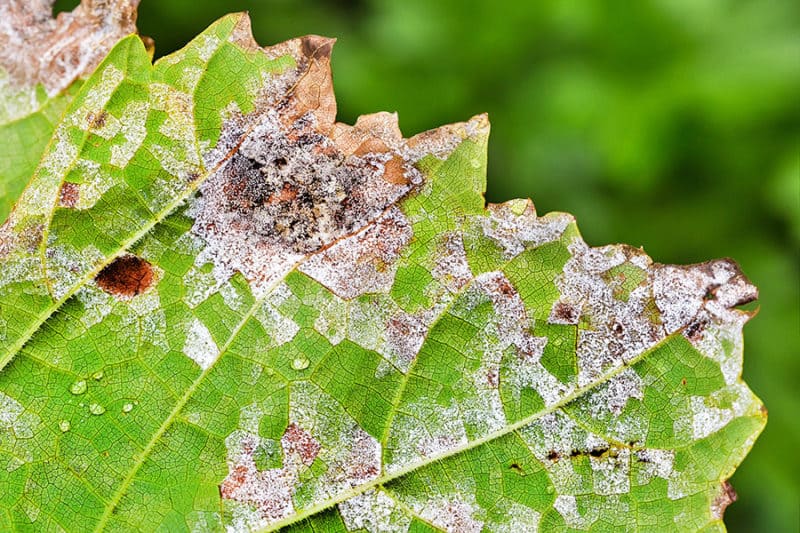
Downy mildew is a covering that forms on your rhubarb in extremely moist climates. If you have periods of rain, don’t be surprised if this forms on your rhubarb.
Make sure that you plant your rhubarb far enough apart that there is ample airflow. Our guide can help you tackle this problem.
Snails and Slugs
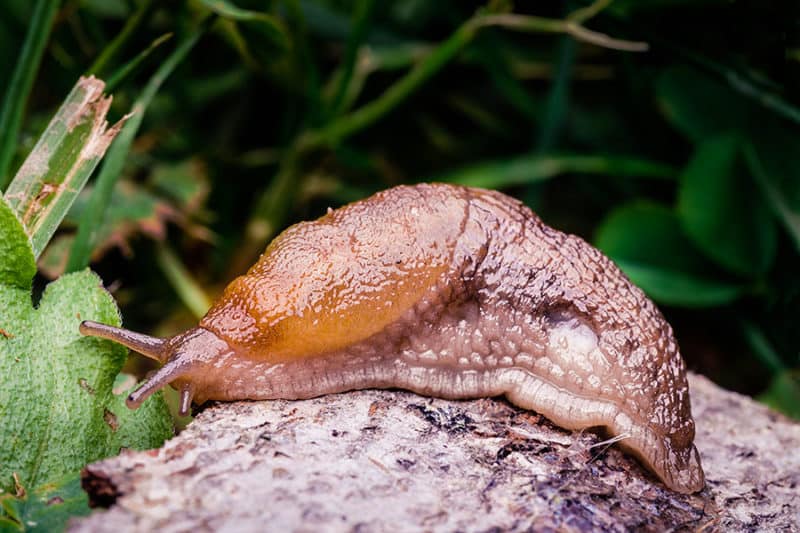
Snails and slugs are in every garden. They can cause damage to rhubarb because they will munch on the stems of the plant. Use your favorite slug control method.
Best Companion Plants for Rhubarb
There are a few plants that rhubarb does especially well growing with. These plants, in general, help deter unwanted bugs from rhubarb:
- Onion
- Garlic
- Cabbage
- Kale
- Broccoli
- Turnips
Don’t plant with:
How to Harvest and Store Rhubarb
Rhubarb is simple to harvest. However, there are some major do’s and don’t when harvesting that can determine how much of a harvest you get and also determine the health of your plants, too. Here is what you need to know:
Harvest the Stalks Only
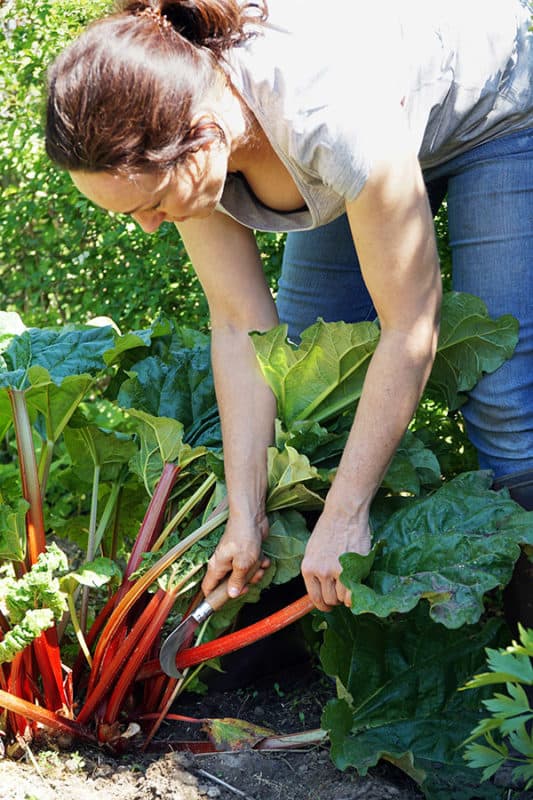
The biggest part of growing rhubarb is to know what parts of the plant to eat and which not. You should only eat the stalks of rhubarb.
The leaves contain a toxic level of oxalic acid, which is poisonous.
When you go to harvest the stalks, pull the stalk away from the plant and give it a gentle twist. If this doesn’t work, then use a sharp knife to cut the stalk from the plant.
The stalks are best to harvest when they reach about 12-18 inches in length.
Keep in mind though, if you begin to see stalks turning thin, then you need to stop harvesting. This is a sign that the plant is struggling for the necessary nutrients.
Don’t Harvest During Year One
When you plant rhubarb, know that your harvest will improve as the years go by. In the first year of planting, you shouldn’t harvest your rhubarb at all.
But by the time you reach year three, you should have an eight to ten-week period where you can harvest from the plant. It is okay to harvest during year two, but do so sparingly.
If you follow these rules, then you should get anywhere from one to two decades of life from each plant.
Harvest Rhubarb Twice a Year
Rhubarb should be able to be harvested two times per year in most zones that grow it as a perennial. You should be able to harvest the plant in the spring and fall.
However, don’t harvest rhubarb during the summer. Leave some leaves on the plant as well when you finish harvesting in the spring to protect the plant from the heat of the summer.
If you harvest rhubarb during the sweltering summer heat, it could cause unnecessary stress on the plant which could cause it to die.
When it’s time to harvest your rhubarb, in most zones, you should prepare to have a full harvest when your plant has around ten stalks on it. Be sure to leave at least two stalks each harvest to encourage continual growth.
If you are growing rhubarb as an annual, you should harvest the entire plant when the summer heat begins.
Clean Up After Your Plant
When the harvest season has ended each fall, it is important to take care of your rhubarb. You’ll know that harvest is over because the stalks will begin to die back.
Once this occurs, you’ll want to cover the plant with a large helping of mulch. This will protect the plant and the mulch will compost and put nitrogen into the ground. This will give your rhubarb a nice boost come spring.
However, be sure that you clean up any debris on or around your plant to make sure that the plant will stay healthy, and you aren’t providing homes for pests and diseases that could harm your rhubarb.
Rhubarb is Best if Used Immediately
When it comes to storing rhubarb, it’s simple. For the best flavor, you’ll want to use your rhubarb immediately. This will ensure that it keeps its crispiness.
Rhubarb is great for baking and freezing for later use as well.
If you aren’t able to get to cooking with it or storing it right away, you should store it in your refrigerator where it is cool. It can keep up to a week.
Be that the longer rhubarb sits, it will lose its crispy texture. Some say you can soak stored rhubarb in water to put some life back into it, but it will diminish the flavor a little.
Harvesting Rhubarb Seeds
Let’s say you’d like to start more rhubarb from seed, and you don’t want to purchase the seeds. Some stalks of rhubarb, in theory, should try to go to seed at some point during the season.
Usually, when this happens, we encourage you to cut those stalks off to try to prolong production.
However, if you want seed, you can let those stalks grow and collect the seeds that should form at the ends of them.
Then, cut the seed stalks off and prepare your rhubarb to be overwintered by mulching it. You’ll want to dry the seeds in a dehydrator before you store them over the winter. You can also store the seeds in a freezer inside a sealed bag.
Using Rhubarb
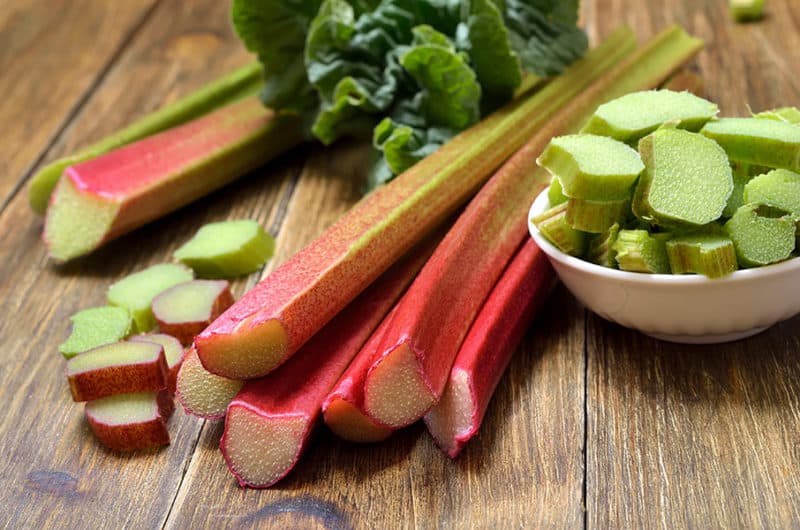
Rhubarb isn’t a typical veggie, so a lot of people have no idea how to use it. Here are some suggestions for ways to use it.
- Make some strawberry rhubarb jam – it’s a kid favorite!
- Try baking a strawberry rhubarb pie, which is a classic dessert with a mixture of sweet and sour.
- Whip up some rhubarb sherbet.
Plant Rhubarb For an Extended Harvest
Growing rhubarb in your garden is a great way to extend your harvest since it pops out early in the year. Since they are perennials, rhubarb will come back year after year. That means you can grow more food with less work each year.

